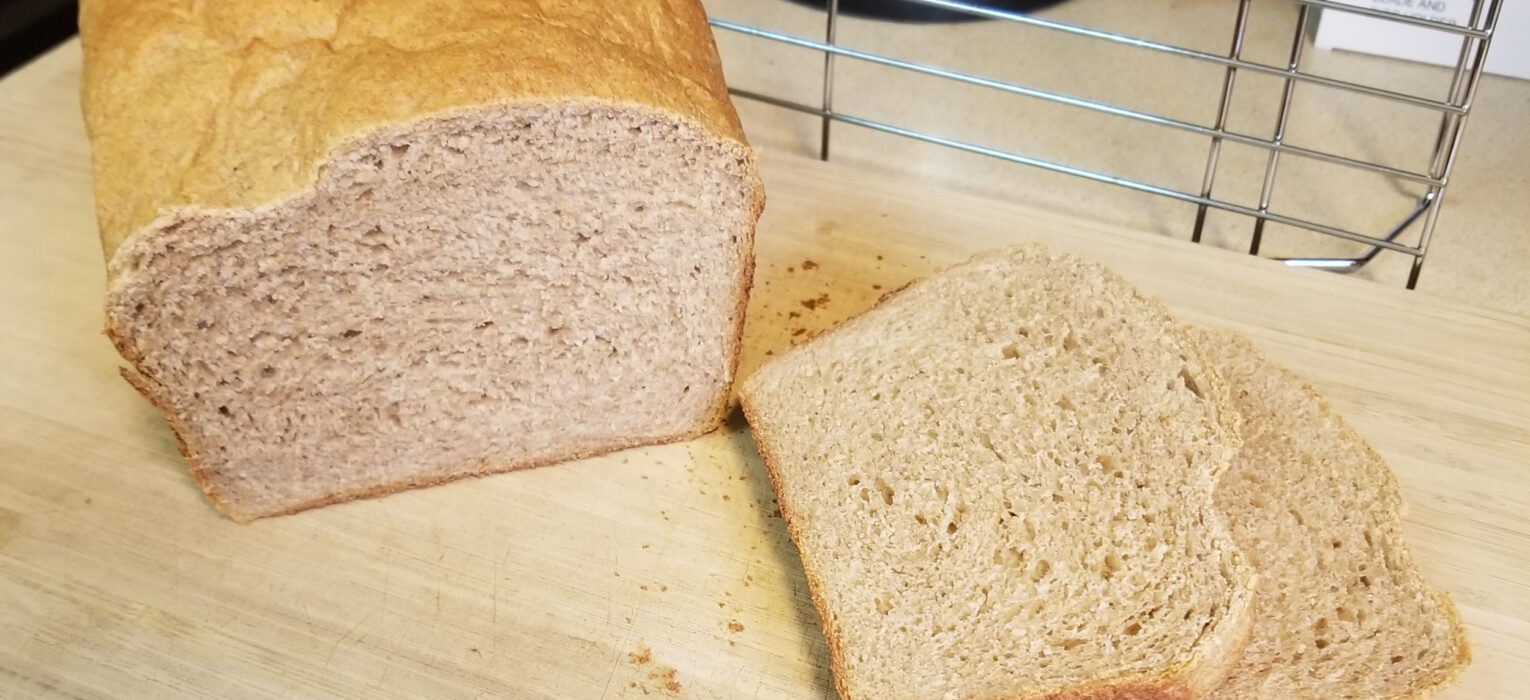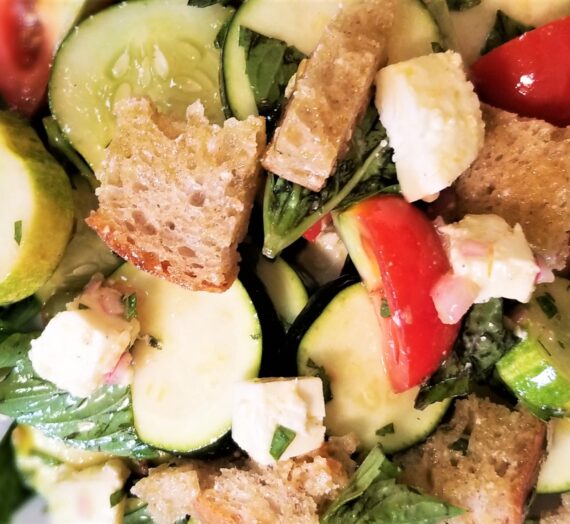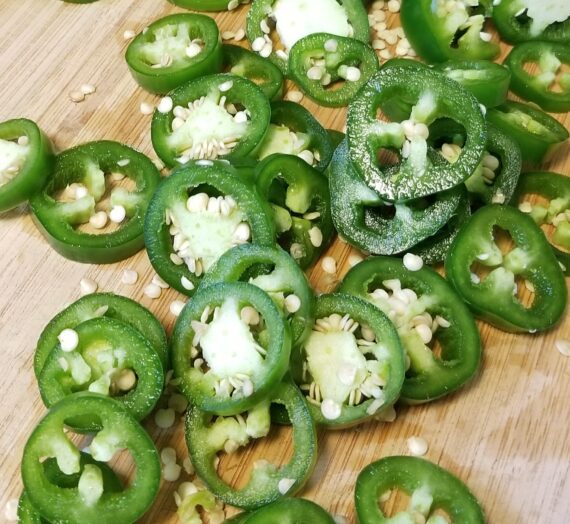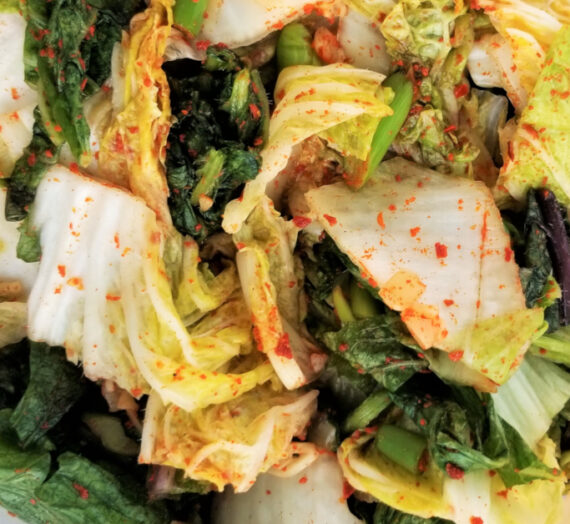On Wednesday afternoon, I made bread. (So did the rest of the world, apparently, but with limited collective success.)
The bread in question was a fairly simple, but delicious, 100% whole wheat sandwich loaf.
The best part? I made it as part of a work day at home! Such are the wonders of our new COVID-19 life, still mostly operational and all from within the safety of our little house. I’m grateful to still be able to do most of my teaching, have a 0-hour commute, AND have a fresh bread snack as a reward when work is finished.
If you’ve never tried making bread before, now is a good time to start. Especially if you have copious amounts of newly-found spare time on your hands, can’t find bread in the grocery stores, and are fortunate enough to have stocked up on flour and other helpful pantry items prior to mid-March.
100% Whole Wheat Sandwich Bread from King Arthur Flour
The full recipe is on the KA website. I suggest following it exactly. If you have any questions, read on for my version and solutions to potential issues, including substitution options.
Liquid volumes are given in liquid ounces. Most dry ingredients are given by weight in ounces. If you have a kitchen scale, use it.
Photos at end!
INGREDIENTS & WHAT THEY DO
- leavener: yeast
- gluten: whole wheat flour, water, salt
- fat/crumb softeners: butter, milk, dry milk powder
- starch & sugar: instant potato flakes (adds moistness and extends shelf life), sugar
- other: orange juice (makes less bitter)
INSTRUCTIONS & CLARIFICATIONS
DOUGH
1. Add 2.5 tsp instant yeast to 4 oz (1/2 c) of lukewarm water in a stand mixer bowl. It will proof very fast.
Optional: add a pinch of sugar to help it proof.
If it doesn’t proof, it’s probably too old. Throw it out and get new yeast.
2. Add to the proofed yeast:
- 4 oz lukewarm (whole) milk, 4 oz lukewarm orange juice.* (aka 1/2 cup of each) I put them in the same glass pyrex and zapped them in 10 second increments in the microwave until they were room temperature-ish.
- 2.5 oz (5 tbsp) melted butter
- 1.5 tsp salt
- 1.25 oz (3 tbsp) sugar
- 5/8 ounce (1/4 cup) non-fat dry powdered milk*
- 1.5 oz (3/4 cup) instant potato flakes*
- 15 oz (scant 3 cups) whole wheat flour (white or normal, either is fine)
*See endnotes for substitutions
3. Mix with dough hook until dough comes together. Then turn the mixer speed to low and let it gently knead the dough for 7 minutes. If the dough appears too sticky, add some more flour. If it appears too dry, add incrementally more water. I had to add about 1.5 more tbsp of water.
Skip to instructions for first rise
No stand mixer? Other methods:
Bread machine: Add liquids first, then solids, ending with yeast. Set on “dough” setting if you want to shape and bake the bread in the oven in a normal bread pan. Or, you can let the machine take it all the way, including baking, by setting it on the “whole wheat” and “1.5 pound” setting, light or medium crust. Either way: During final kneading, open the lid and check that the dough isn’t too sticky or too dry. If too sticky, add flour 1 tbsp at a time. If too dry, add water, c. 1/2 tbsp at time.
Food processor: You could probably make this dough in a food processor, but it would need to be higher capacity than my “little” 9 cup one. Good luck.
Old-school method: Mix with a wooden spoon in a bowl until dough comes together. Turn out onto a very lightly floured surface, and with floured hands, knead dough for (likely more than) 7 minutes. Only add flour if dough persistently sticks. The more flour you add, the tougher and denser the bread will be, so avoid over-flouring.
This is a good video of how to knead.
4. Place dough ball in a large pre-greased bowl. Cover with plastic wrap or towel and let sit for c. 1.5 hours, or until the dough has doubled in size.
SECOND RISE
5. Turn the dough out onto a lightly floured surface, and shape it into a log.
This is a good video for learning to shape dough.
6. Place shaped dough in 9×5 inch pre-greased bread pan, cover with plastic wrap or towel, and let rise for an hour or more until the dough has risen to just under an inch above the pan rim.
BAKING
7. Bake at 350 F for 40-45 minutes. Halfway through (or 10 minutes in, as per the original recipe), tent with aluminum foil to keep it from browning too much.
8. Bread is done when its interior is 190 F. (I stabbed mine with a digital meat thermometer to make sure.)
9. Remove from oven, turn out from pan, and cool on a wire rack.
AFTER
There is nothing like fresh bread straight from the oven! We sliced a few pieces and enjoyed them with whipped orange honey butter, gifted by one of my harp students. Then we sliced and froze the rest for future sandwich and toast needs.
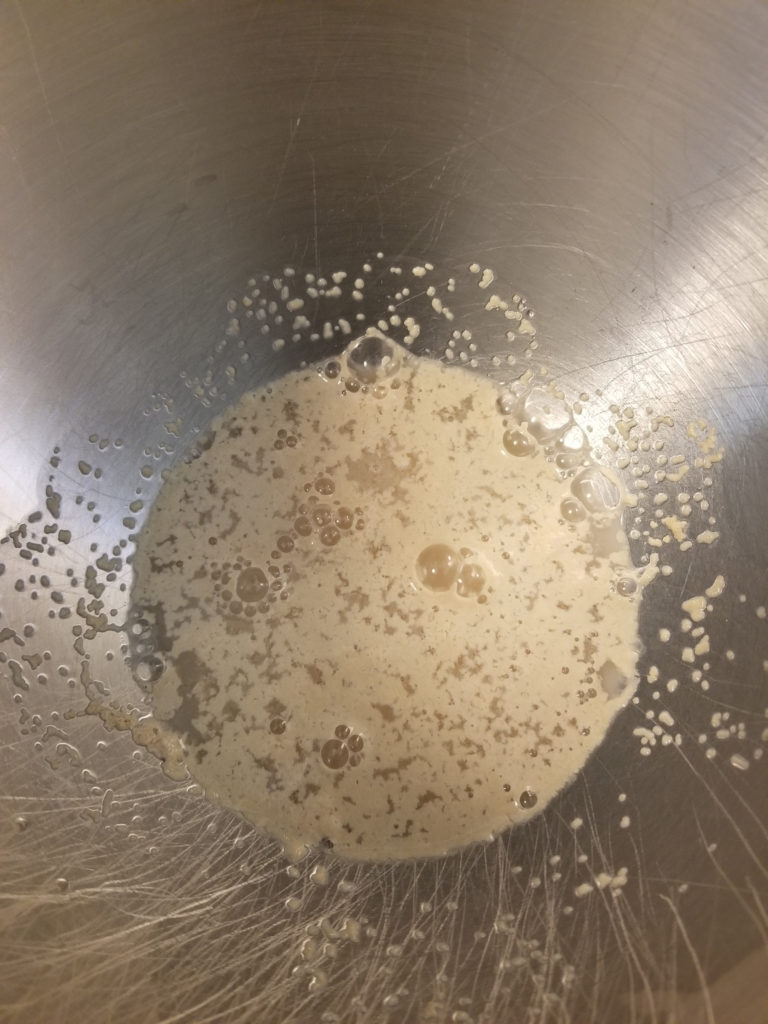
Instant rise yeast (aka bread machine yeast), successfully proofing. 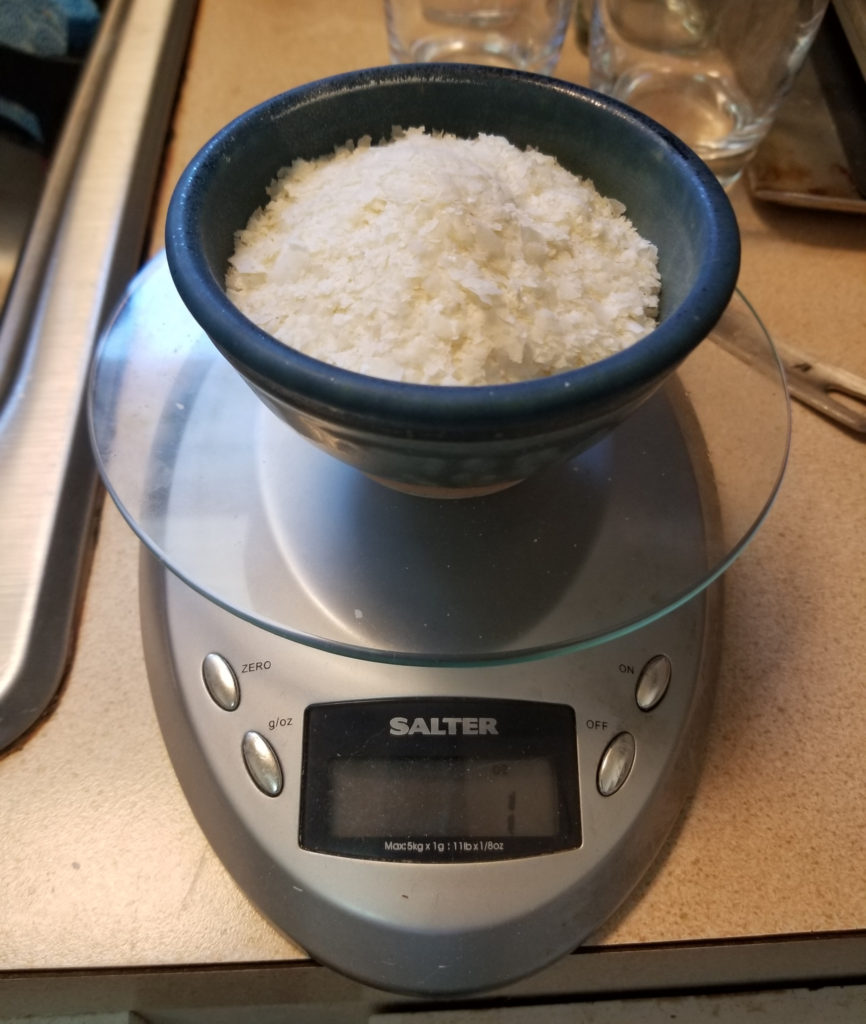
Kitchen scale for the win! 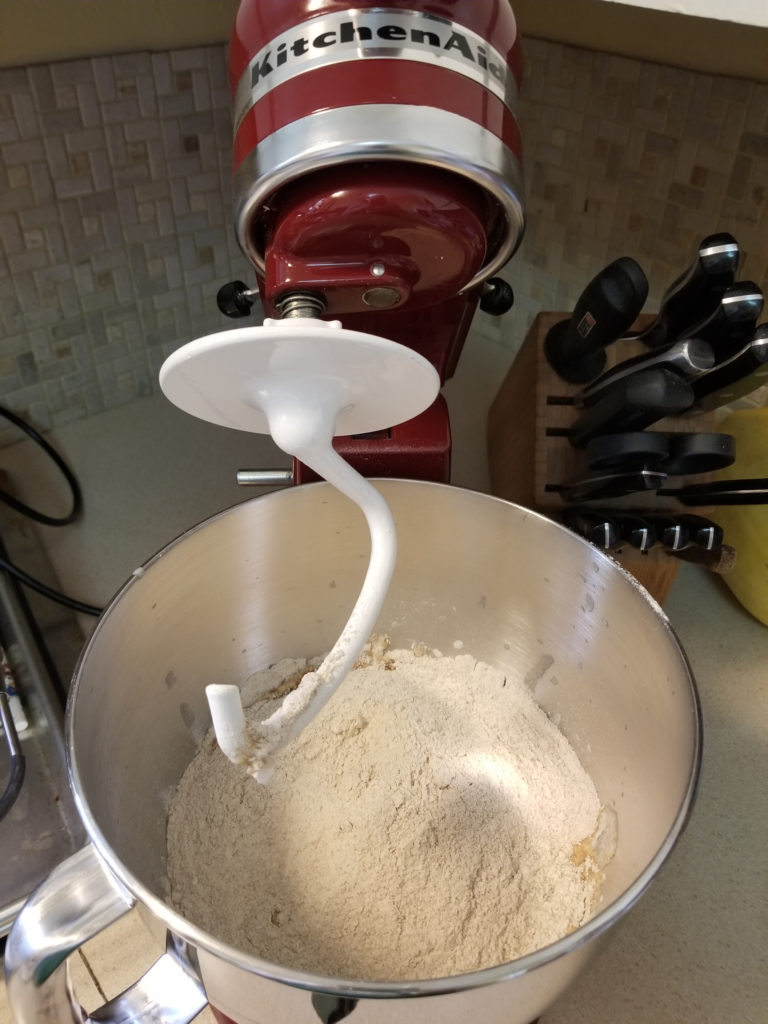
Kitchen-aid mixer with dough hook cuts down on tendinitis while kneading. 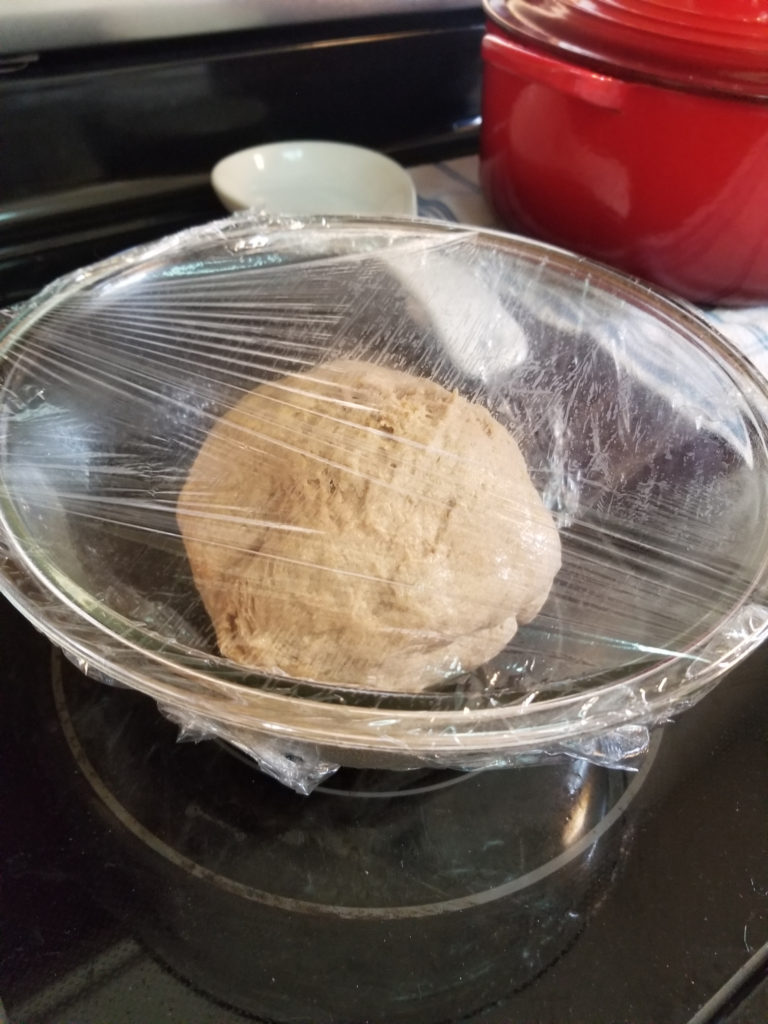
First rise. 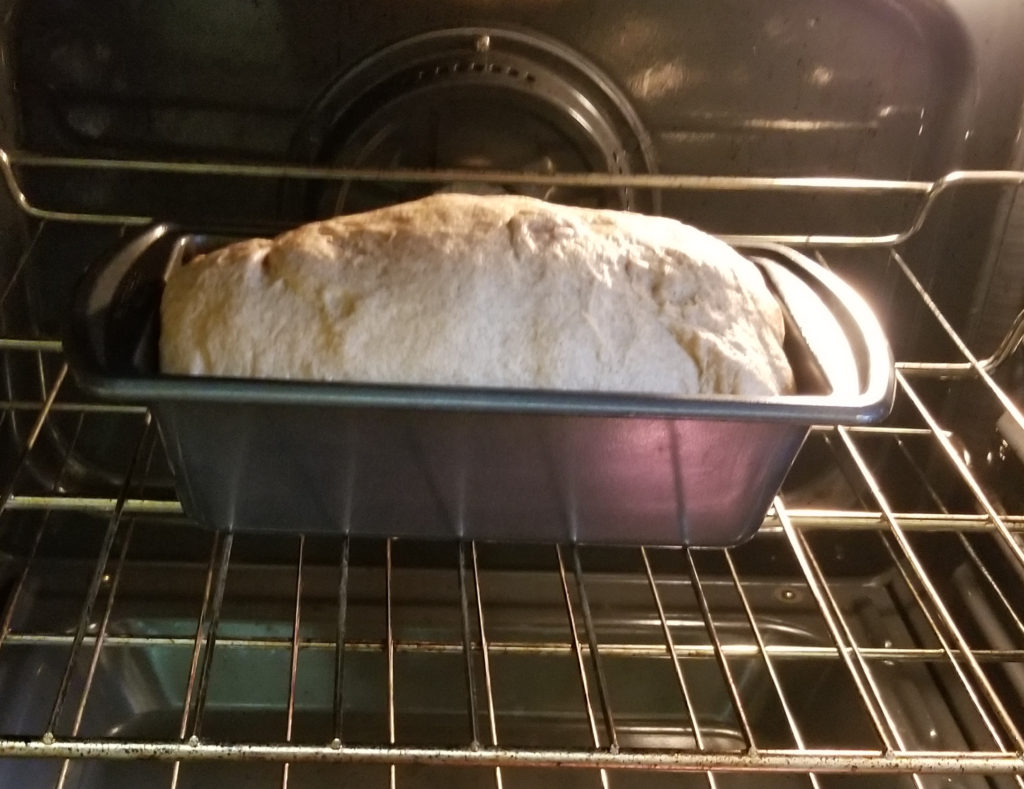
Forgot the shaping/2nd rise photo. 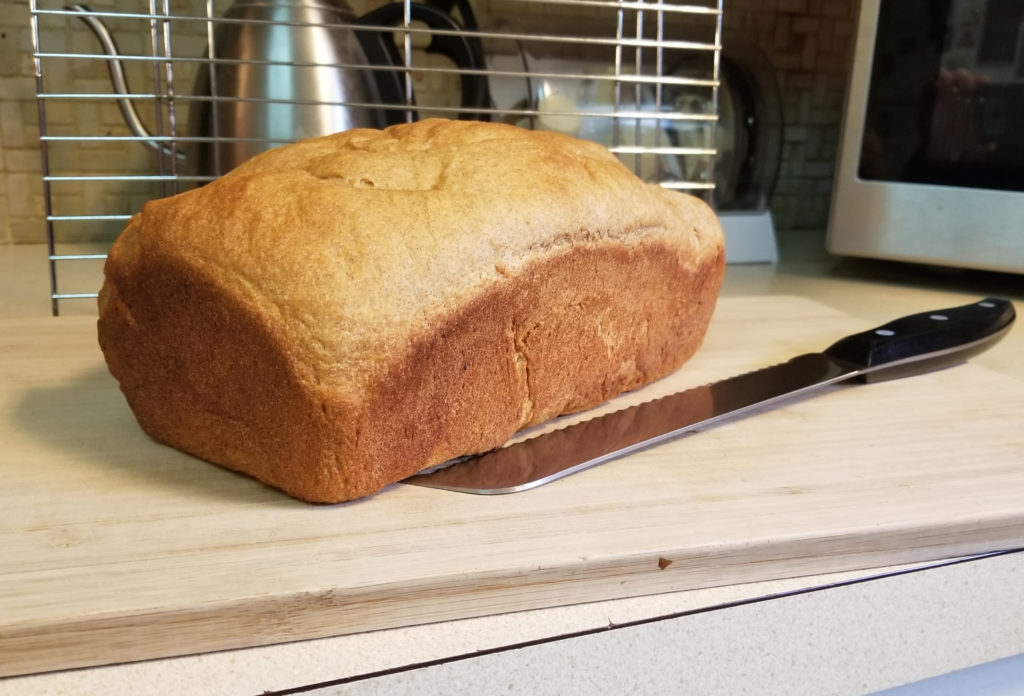
The finished, cooled loaf.
Alas. If you don’t have either orange juice, dry milk, or instant potato flakes on hand, try these substitutions and alterations:
Orange juice: Function in this recipe is to offset the bitterness of the whole wheat flour. You could sub milk for it by volume. If the taste is a major concern, and you don’t have to have a 100% whole wheat loaf, then consider replacing half of the whole wheat flour with all-purpose or bread flour.
Dry milk: 1/4 cup dry milk + 1 cup water = 1 cup milk. So, use 1 cup non-fat liquid milk in place of the dry milk in this recipe. Then reduce the amount of added liquid (total among the milk, water, and OJ) to 1/2 cup instead of the 1.5 cups the recipe originally called for.
Instant mashed potato flakes: This one’s tough. Common sense says you should be able to substitute mashed potatoes. From what I’ve read, that works better for rolls than for a loaf: The baked loaf may be too soft, not maintain its shape, and collapse. You could try real mashed potatoes as a sub anyway, but perhaps add vital wheat gluten to help stabilize? Otherwise, you can use the same volume (3/4 c) of all-purpose flour or cornstarch to sub for the instant potato flakes. Here’s what to do:
- A/P flour or cornstarch: Use 3/4 c of either instead of the 3/4 c of potato flakes. Reduce the total amount of liquid slightly. (I would personally never use cornstarch; 3/4 cup of cornstarch just sounds gross! But, maybe it would work?)
- Mashed potatoes: Sub 2.25 cup of real mashed potatoes (sans cream, butter etc) for the 3/4 cup potato flakes in this recipe. Then, reduce liquid in the recipe by half. Hope the finished loaf doesn’t implode.
- Potato flour or tapioca flour could probably also work. You’re on your own Googling adjustments there.
